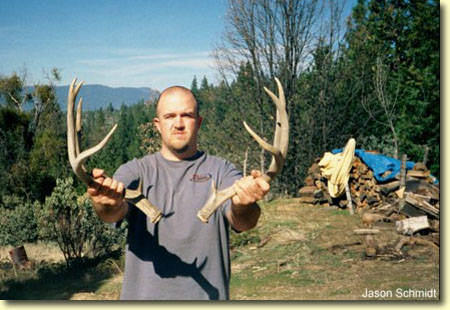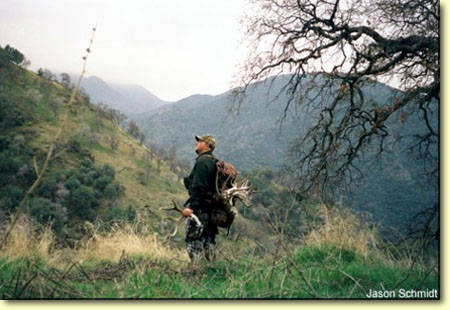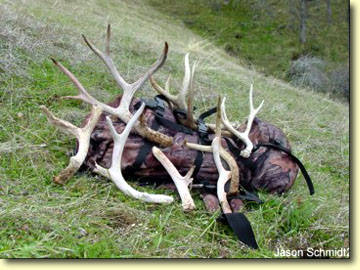"Shed Hunting"
Written by Jason Schmidt, aka BuckSnort here at MonsterMuleys.com
 |
Shed hunting has become very popular over the past few years, and with good reason. First off, it's good exercise and a lot of fun when you finally spot your first antler of the day. It's also fun to think that maybe the antlers you find are from the bucks that outsmarted you the previous fall.
In the next few paragraphs, I will share some tips I have learned over the years about shed hunting. And hopefully, you'll find them helpful.
The first thing you need to do is find out where the deer are between January and April. The reason being, this is when most deer shed their antlers. Although the majority of bucks shed in late February to early March, some can drop as early as late December and as late as April. It depends in part on the geographic location of the deer. The further north you go, the earlier the bucks shed their antlers.
To find sheds, your first step is to find where the deer are during the antler shedding period. I usually do this from a good distance away, through my binoculars and spotting scope. That way, I can watch the deer without spooking them.
 |
The next thing you will need to do is get some 7.5 minute topographical maps of the area you'll be shed hunting. Once you get the maps, you will need to sit down with them and find likely areas where bucks will be spending most of their time. Look for ridges or flat benches where a buck might want to spend his afternoons bedding.
In most areas, I have found that bucks like to be in the same type of terrain on the winter range as they do in their summer range. Keep that in mind as you study your topo. maps.
Funnels make easy travel routes for bucks and you should check those areas out as well. A funnel can be a saddle between two ridges, a break in the vegetation, or any type of change in terrain that makes it easier for the deer to get from one area to another.
Springs and water tanks are also a good place to find sheds especially in the desert types of winter range. Look for ridges near the water sources, because there is a good chance of a shed or two being there.
 |
Begin to look for clues to the whereabouts of sheds. Usually, if you are in an area where bucks spent a lot of time, you will find a few rubs and other sign that the bucks are, or have been, in the area.
Of all the areas I have found sheds in, I have found that bucks shed their antlers in or around the same area they rut in. Find the bedding areas and walk slowly through them while looking for sheds, I would say around 75% of my sheds have come from bedding areas. This makes sense, because this is where bucks spend most of their time. Feeding areas are where most of my other sheds have come from.
One thing I have not discussed yet is the pressure on the mule deer herd on the winter range. Certain areas have a more harsh and severe winter than others, this makes it harder for the deer to survive on their own and the last thing they need is someone on a quad or 4x4 ripping up and down every hill and valley. So, be responsible while in the field.
Click-a-Pic ... Details & Bigger Photos
Click-a-Pic ... Details & Bigger Photos
Videos | Hunts & Tags | About Mule Deer | About Elk
Classified Ads | Photo Tours | About this Site | Advertising |
Older Content | Email Us | Privacy Policy
